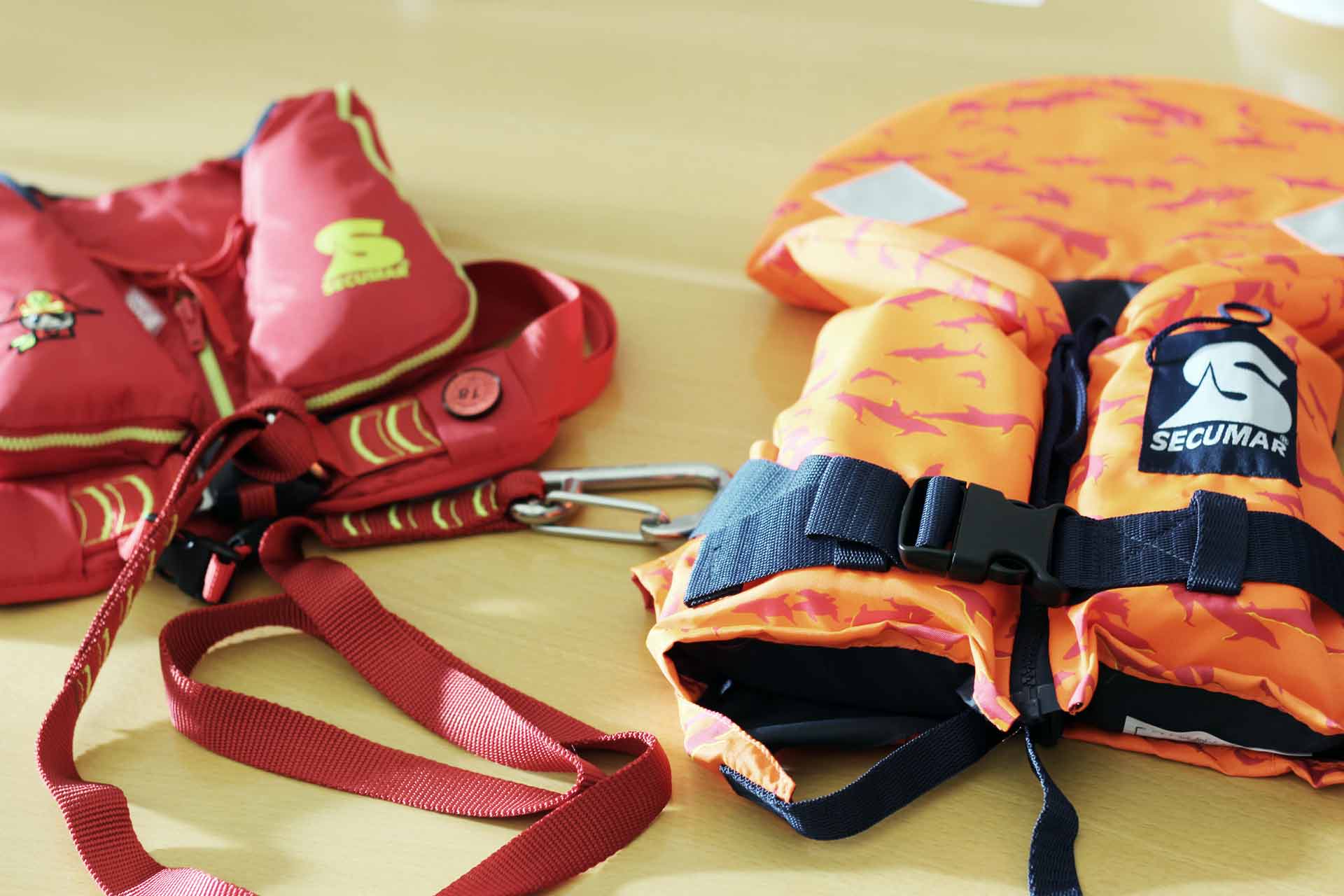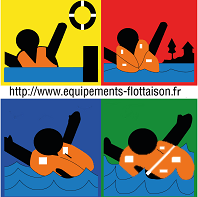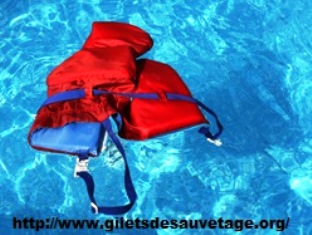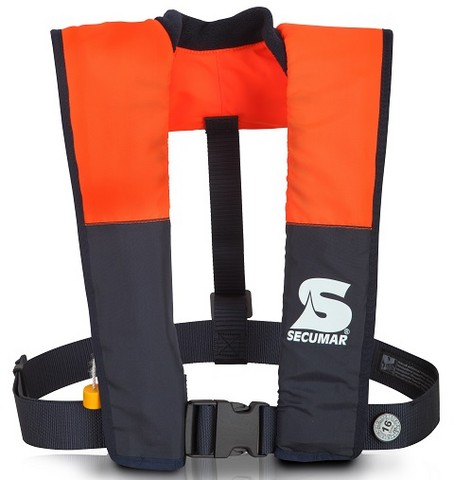Being a responsible Skipper and showing good seamanship (here´s an article on that particular topic) doesn´t just mean to have the sailing skills but also (and much more) to be responsible for all onboard. Especially taking responsibility for all those who just want to have a pleasant time onboard – the non-sailors – and of course the smallest passengers: Children. As being a sailing dad by myself child´s security is an utmost concern. Because children do need special care, onboard a sailing vessel as well as at home. I´ve recently had the pleasure to have a chat with Head Physician of Children´s Hospital Itzehoe near Hamburg and passionate skipper Dr. Hillebrand on first aid-measures and lifesaving procedures for children (here´s the article) and now I took my chance to talk to the leading manufacturer of life-jackets, SECUMAR. I was interested in the whole topic and had prepared a ton of questions. I was very keen on having them answered. When asking for an interview it took not more than two days to get a response and a warm invitation to meet the safety-guys at the SECUMAR headquarter: What an exciting day with deep insights behind the scenes.
A Hamburg Veteran next Door.
Germany´s “Gate to the World” – that´s Hamburg indeed and one of the busiest and biggest ports of Europe. It´s a very old Hanseatic city and was and still is headquarter for numerous big and small corporations, shipping companies and yards which had it in past times and still have it: A worldwide respected and wellknown brand. SECUMAR is one of them. In need of much more space than ever this firm went from Hamburg´s waterfront to the more rural outskirts of the city: A small village called Holm, near Pinneberg. There I am meeting Olivier Christen, French born Sales-Manager Sport with whom I was going to have the interview. Very personal stuff is moving me to puch for a date here at SECUMAR: Last summer, when taking my King´s Cruiser 33 from the Baltic Sea via Kiel Canal to Hamburg (read thefull story here) I do witness a small boy not older than 2 years taking a wrong step and falling into the cold waters. Thank God he was wearing a life-jacket. But coming back to surface the boy wouldn’t turn into dorsal position. Most dramatic seconds which seem never ending. Like taking hours. In the end everything is fine, the boy is rescued very fast and safely and no injuries will remain. But a sadden feeling remains. Having my own children as passengers sailing with our SY OLIVIA I want them to be protected the best possible way. It´s a good thing that SECUMAR is just a 20 minutes drive from where my yacht is in winter storage to meet Olivier Christen.

The big meeting room makes me wonder: Next to Olivier another person enters the room. Benjamin Bernhardt, CEO of SECUMAR. “The Senior will join us soon as well”, he says and we spend some minutes chatting about this and that. Then the second CEO arrives: Being a Bernhardt himself as well: Jan-Ulrich. The father. Again I have to wonder. I didn´t knew that SECUMAR was and still is a family business – not that big faceless manager-run giant, ruled by invisible hands and the wills of shareholders in a brutal global business I had it expected to be. They do run it in fourth generation now and both Bernhardts as well as Olivier are going to spend some five hours with me. Very sympathetic: I am allowed to ask every question I want, can speak openly and have a look in every corner I want.
This is what makes a children´s life-jacket outstanding.
“Why did the child back then in Kiel didn´t turn around?”, I want to know from both bosses. “Well. In the end”, Benjamin says, “children are something very special here. They are special because of the composition of their bodies and the proportions on the one hand, and on the other hand because of their clothing.” Looking at a child´s head, Benjamin explains, you will notice that it weighs so much more in comparison to the rest of the body. That moves the center of weight to the top of the body: This is very unfavorable. “To stay safe and upright afloat a human body has to work like a buoy.”, Jan-Ulrich, the father, joins the discussion, demonstrating with his hands: “You need a lot of buoyancy concentrated at the top. Furthermore down below you need a center of mass. Just like a lead-keel on a sailing yacht. But having a heavy head and an ordinary live vest with buoyancy concentrated in the middle of the body, head forcing weight down, that´s a tricky situation. The vest will force the body stay afloat, but the leverage will be put in the middle, at the child´s belly. In the end, the child will remain flat in the water instead of virtually standing in it.”

“Diapers are a big problem. As well as high-tech Gore-Tex clothing”, Benjamin Bernhardt adds: “Diapers take in water very slowly and thus create huge uplift. In this case bad buoyancy. This is during the first minutes at a very, very unfortunate spot: Down at the body. If this child is then wearing watertight clothing, an air bubble can form underneath the jacket creating an air bladder and adding buoyancy where it´s not needed … no chance here.” I do begin to understand the problem: Obstacles to have a child´s body lifted in an upright position in the water are plenty: “Solid foam life-jackets do produce lift indeed, but there can never be a guarantee to have the child in the right positon. It´s just impossible to have a 100 per cent safety here. To flip something a lever is needed. With a child, that must be a very strong leverage arm.” I see – children´s life-jackets are some kind of the supreme discipline in that business. A business in which SECUMAR seems to be leading.
The “Collar-Principle” as a Learning from the War
Grand Grandfather Karl Bernhardt founded his “Bernhardt Apparatebau” back in 1926 constructing and building underwater breathing machines. His son, Grandfather Jost is seen as the “father of the life jacket” because he was the one who started to seriously research into security devices for marine application. “My father was not a member of the Kriegsmarine during World War 2”, says Jan-Ulrich, Senior Manager of SECUMAR, “But he had to go through horrific things during that time. He was always talking of the lifesavers of those days as being “drowning devices”, because they did not really save lives. They were useless in his eyes.” Jan-Ulrich explains a man over board would have to struggle actively to stay afloat above water: “If a person would become unconscious, it was his sentence of death. Simply as it is: Nothing would work for him keeping his head above the waves. He would simply slip below water and drown.” The loss of the sailing vessel PAMIR in 1957 with 80 mostly young cadets (out of a crew of 86) drowing was the final trigger for Jost to actively starting research. “It was crystal clear for him that the key to a safer device would be the safety against unconsciousness.”, Benjamin adds.
Staying in business of selling the old school devices Jost was working hard on his idea: “He wanted to skip the dogma of the life vest concentrating buoyancy around the waist, which was counterproductive in his eyes – he was favoringan idea to relocate buoyance further to the top. Just like a collar.” So stability would be added by having a counterpart as center of mass down below, at the toes, like a keel of a yacht: “This is what he constructed and tested thoroughly.”, Jan-Ulrich adds proudly and shows an original print of “Man´s Behavior in the Water Medium”. As so often in our times it was the military showing interest in his research. The then freshly founded new Bundesmarine was one of the first clients of Jost Bernhardt´s new product.

Newton, Body Weight, Height … which Standards for Life Jackets do exist?
“Generally speaking all life jackets are divided into so called performance classes.”, Oliver explains and shows several still boxed life jackets. I can find printed marks, on one of them it´s stated: 100 N. “Newton, that was the measuring unit for … power?”, I am trying desperately to remember my seventh grade physics-education. “That´s perfectly right. Because that is the force with which the life jacket will pull the person towards the surface of the water: It´s the buoyancy.” Life jackets are divided into four performance classes: 50, 100, 150 and 275 Newton. “The more N your life vest has the more buoyancy it can generate.” And the safer it will be in the end? “Yes, you can see it this way if you like. But here´s where it gets complicated: To generate, let´s say, 150 N of buoyant force pulling you up with a solid foam jacket you need a lot of foam or, as in past times, cork. This makes the life vest very thick and uncomfortable. It will disable movements and thus no sailor would have them wearing all the time, just in case of emergency putting them on. It´s still a problem today: That’s why solid foam vests are available only for the lower performance classes.”
Benjamin Bernhardt goes on: “These performance classes are not the only thing. Because life jackets are also divided into different weight classes. For example a vest for a child, weighing much less than an adult, wouldn´t have to generate the full 100 Newton but effectively not more than 30 Newton to pull it up. So performance classes are scaled down to the different weight classes.” Looking at myself being a lightweight, my 100 N life vest would effectively just need to generate 80 N of real force. Sounds legit. “But when we talk of body weight it gets more and more complicated,” Jan-Ulrich says: “Because what matters most in the end is not really the weight of the mass but the so called specific weight of the different body-parts.”

What is that? Different parts of the human body are made up of different materials with a different thickness of layers of muscles (heavy), fat (light), the brain (very heavy) or bones (also heavy). “Our limbs for example do have a higher specific weight in the water than the torso. Looking at a child´s body the high portion of baby fat will turn the whole equation upside down again.” Both try to explain the problem with a picture: What will sink faster: One kilogram of lead or one kilogram of straw? “Both are weighing exactly the same but their different specific weights will cause the straw to sink much slower. If you add buoyant diapers or watertight and air-encasing clothing it gets very, very complex here.” So, with all those obstacles and uncertainties isn´t it impossible to develop and test safe and reliable life jackets for children at all?
Introducing Bambi: Or, how a Child´s Life Jacket is tested.
Yes, you can, both Bernhardts are reassuring. But you can only do it thoroughly with dummies on the one hand and on the other hand because all have agreed on one standard of how to test: “Just because of different children having all sorts of different diapers and clothing on a standardized procedure of testing had to be introduced to have a graded system to work on.” This graded system says that testing will be done under identical starting positions worldwide. “A child wearing swimming trunks – as well as for adults – is the worldwide standard of testing.” Additionally there are the dummies: Not a single caring mother would dare to hand over her child to test a life jacket in a realistic setting (here´s an article of my own MOB-test)

“Well, of course you can make these tests with real children. And we regularly do have them. But they are not very meaningful to our minds”, Benjamin explains: “During the tests we are observing the so-called bathtub-principle.” What could this be? Benjamin asks me what would happen to my arms when I would relax in my own private hot bathtub. “Well … they would float … maybe?” “You see, that´s the problem! Everybody´s arms will come to the surface whereas they should be sinking like stones to the bottom because their specific weight is much higher. That is the bathtub-principle. If you would be really relaxed – as is the case with people being unconscious, your arms would sink down.”

Solid Foam Life Vest vs. Self-inflatable Life-Jacket for Children
Just as we take Bambi out of his (or her?) cold wet bath we go on having a look at SECUMARs production facility. I again mention the little boy falling into the Baltic Sea during the transfer cruise of my own sailing yacht – he was wearing a solid foam vest indeed: “So, do I get it right: Solid foam vests for children are if anything but unfavorableand you would personally dissuade from using them?” Jan-Ulrich nods and shakes his head at once: “It´s not that easy, you see. Both systems have their clear advantages – and of course their own disadvantages.” As he continues to explain, he says that every pro of the one system is the contra of the other. “A solid foam life vest can always just be a compromise at the undermost edge. Just because buoyancy is closely connected to solid packs of foam. A solid vest is uncomfortable to wear and it can get very hot underneath it and it is just restraining the bearer.” I can imagine that. But: “Solid foam life vests are practically free of maintenance and relatively immune against damage.”

“Achieving safety against unconsciousness is not the primary goal of a solid foam vest”, says Jan-Ulrich: “We recommend to have them on whilst anchoring or in harbor. As soon as the yacht is mooring or tied to the pier, this vest will be put on and you can let go your child.” If the child goes on to wear the vest when playing at the marina´s playground and having a fast game of “Come and get me!” through the bramble fruit bushes – that´s something a solid foam vest is likely to stand up against without damage: Having an inflatable life jacket is prone to damage. “When your child will accidentally fall into the waters of the marina – just as you have experienced it – normally there´s a fast rescue at hand.” But things look different when underway, Benjamin Bernhardt dissuades from having solid foam vests off shore. “To state is blatantly: We strongly recommend having a self-inflatable life-jacket for your child when sailing and going off shore.”

Nothing speaks in disfavor to put on a self inflating life jacket to toddler: “The lever arm of such a life jacket works very effectively – the buoyancy it creates is situated at the top, like the mentioned collar. These types of life saving devices are much more effective. In addition to that, the jackets do bear a D-Ring or harness, if you like to call it, to have them safely connected with a lifebelt. Besides, we do have the daily experience that children seem to accept those life jackets better and faster that the sturdy solid life vests.” Nevertheless, Benjamin warns, inflatable life jackets have to be maintained regularly and do not get along well with bramble fruit bushes. And they are not able to grow bigger along with its bearer: “An inflatable life jacket must always have a perfect fit – which is also valid for adults – and parents shouldn´t buy such a jacket for their children to grow into the jacket.” When buying, parents should have a fitting of the jackets both with and without clothing. I do memorize: My children will put on their solid foam vests when entering the harbor and switch to inflatable when leaving it.
Which Children´s Products can be bought?
“At SECUMAR the share of children´s products of the overall sales volume is tiny.”, Benjamin admits. “It´s more that we feel a certain responsibility to have safe products for childrens´ security onboard as a part of our product range. Also because a lot of other manufacturers simply do not offer these products or just have solid vests.” For example, in the United States the utilization of inflatable live jackets is opposed by the official authorities up until the age of 16, grandfather Jan-Ulrich adds.

SECUMARs product range comprises three life jackets with self-inflating capabilities: MINI, JUNIOR and ARKONA all three of them in the 150 Newton performance class. There are also three solid foam life vests available for skippers who travel with children in the 100 N performance class. “In the end we as a company can only set the highest possible standards in all stages of the production, R&D and quality management to send our products to our customers to the best of our conscience. Finally it will remain a compromise, always. We want to cover as much aspects as possible – but unfortunately there cannot be a guarantee of 100 per cent safety.” I fully understand. “What is of utmost importance as well is that sailing parents do apply additional measures for their children´s safety onboard: A safe harness for example and of course explaining and training on board is essential.”
Legal Standards and Seals of Approval: This is how a Skipper hedges his best.
But how can a skipper identify a safe and high quality life jacket out of the broad range of diverse products available? “Europe and Germany in particular have very strict rules and guidelines concerning the production of SOLAS-equipment: It is called the PSA-Guideline 89/686/EWG for example, an ISO-certification which is in our case the ISO 12402 production on a state-of-the-art level. This is one thing a customer can have a look at when deciding which product to choose.”, says Jan-Ulrich Bernhardt. In Germany there are additionally very strict official design-tests and a permanent regulatory monitoring of the ongoing production, as it is done by the DGUV. “These high standards do only apply to products Made in Germany”, Benjamin adds.
In the United States there is a profoundly different system. “And a different philosophy too”, Jan-Ulrich Bernhardt explains: “In the US there´s a high emphasis on UV-resistance for example. They do rate this feature very high overseas. So, a careless skipper might throw his life jacket into the sun and can let it lay around for months is something that is regarded a high priority there.” Criteria which are insignificant for survival in the water, both agree. “Of course, there´s also a different pretension because the legal system is working different in the States.”, Jan-Ulrich further explains: “In the US everything related to compensation is of highest interest. Safety standards are designed around an average: Out of X cases there has to be reached a certain average. In Europe that is different: We have a system of minimal requirements: At least a minimum of X has to be reached. I think that´s a great difference here.” And if then a “U.S. Coast Guard approved” is printed on a life jacket or not doesn´t seem to be a real sign of quality here, TTIP greetings …
Inspired by Customer´s Feedback: SECUMAR Duo Protect.
What´s about product research and development? Or to specify: Feedback generally, I want to know. All three of my conversational partners do nod, because feedback is gladly welcomed and desperately needed: “We do welcome every single report we receive when people use our products. Have to use our products, one must say, but this helps a lot to continually improve our products.”, Benjamin agrees. He tells a certain story of a Danish sailor. His feedback let to the breakthrough in developing a safer children´s life jacket: “He was sending back the life jacket of his son twice. Every time the device had several punctures in the floating body and he was accusing us having course the damage. But that was just was impossible: Our quality management is a multi-step 100 per cent check of every single product. But it was this particular incident inspiring our engineers to a truly revolutionary invention.”, Olivier Christen says.

“Unfortunately constructive feedback is seldom”, Jan-Ulrich regrets the fact that: “Mostly it´s the authorities or the detectives who are part of an investigation when a fatal incident at sea involves safety devices made by us. Or it is unsatisfied costumers.” Jan-Ulrich Bernhardt would like to see a Club of Survivors, as he called it: “That´s something I would rather like. Because, when our products do what they are supposed to do – get inflated and contribute to the rescue of lives – that´s something people should also talk about. But they don´t. These are much more stories than the fatal and they are rather happy ones.” Back in 1977 Germany had mourned 80 drowned people over the year, whereas in 200 it was only 2. “Sadly enough, people who get rescued are often ashamed and don´t want to talk about their incidents. That´s a pity because it´s their experiences which is valuable information for all of us roaming the waters and the seas. It´s stories showing that our products are reliable and properly functioning.”
Children at sea: Practical Tips for the Sailing Family
At the end of my day in Holm I get a guided tour through SECUMARs production facilities. What really impresses me:The number of quality controls and safety measures within the process of manufacture. For example, at the start and at the end of every roll of synthetic fabric out of which the floating bodies will be produced a testing device will be formed and destructively tested. Only when both tests have been accomplished with success the whole batch is cleared for the next production step. Each and every trigger mechanism of the life jacket is tested by hand – by the way, we do manufacture them handcrafted in partnership with 13 handicapped workshops in our vicinity here. Every single CO2-cartridge and every single pellet for the triggering mechanism will be checked manually as well.” All life jackets undergo an inflated 16-hour-test: “The combination of our safety measures is unique and unheard of in the whole business.”
Looking at the costly production and quality procedures it´s no wonder that SECUMAR life saving devices are the only life jackets which have got the approval by the strict regulatory measures of the German Water- and Shipping Agency. German military has its safety-equipment produced at SECUMAR exclusively: “Out of all staff-members we have every tenth colleague working directly for quality control, another 10 per cent are engaged in R&D.”, Olivier Christen finishes his tour through the halls of SECUMAR. High invest, an extremely dense safety-net, local (hand crafted) manufacturing: That all will deposit in the overall price of the product. SECUMAR life jackets are no cheap articles at all.

Many thanks to Jan-Ulrich and Benjamin Bernhardt as well as to Olivier Christen for the open, diverting and very sympathetic hours at SECUMAR, answering all my questions. Thanks to Bambi for jumping into the cold waters demonstrating the function of a toddler´s life jacket. If you, dear reader, have some time to spare in Hamburg, don´t hesitate to take a tour through SECUMARs museum – it´s worth a visit.








